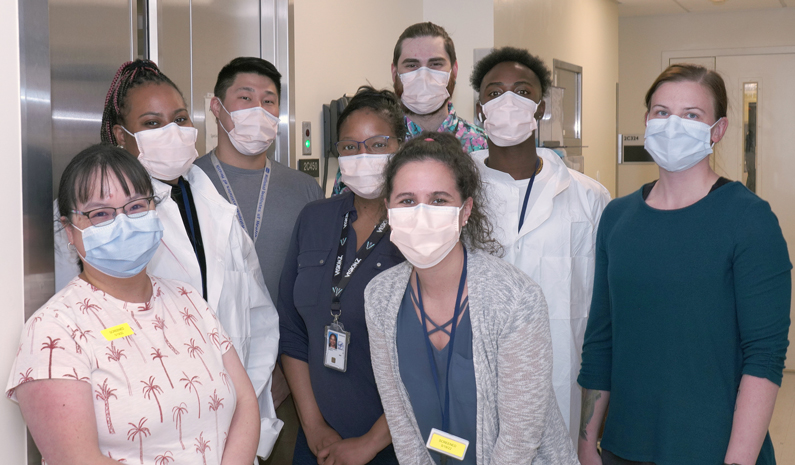Clinical Center cGMP Sterility Lab is first of its kind in an academic hospital
Lab fulfills hospital need; moved into new space in May

The Department of Laboratory Medicine's (DLM) Sterility Lab performs behind-the-scenes operations normally taken for granted at the NIH Clinical Center. So when the lab received a CEO award last December for Innovation, the 12 front-line bench technologists and three managers were very excited, according to Dr. Anna Lau, the chief of the Sterility Testing Service, who led the lab's establishment.
The award recognized the outstanding inter-disciplinary collaboration that established the cGMP Sterility Lab to "support the NIH cGMP program for Investigational New Drugs discoveries and patient care innovation."
Current Good Manufacturing Practices (cGMP) are a set of Food and Drug Administration (FDA) regulations designed to ensure that a medication is safe and has the ingredients and strength it claims to have. There are stringent requirements for the methods, facilities and controls used in manufacturing, processing and packaging of a medication.
NIH Leadership identified the cGMP Sterility Lab as a critical need at the NIH in 2015/2016, following two high-profile product contamination events, FDA inspections of multiple facilities and the Red Team report.
Since 2018, the Sterility Lab staff worked many additional hours, not only supporting the 13 different manufacturing facilities on the NIH campus, but also building new microbiology lab practices needed to meet cGMP compliance. They created a new lab from scratch, including hiring and training personnel, establishing practices, creating documents and implementing new systems.
There was even construction of a brand-new physical cGMP lab that they moved into in early May 2022. During construction, they operated in a temporary lab in Building 10, while creating the foundations for improved cGMP practices.
"Every team member in the Sterility Lab stepped up 200% to not only complete the high-volume daily work duties, but to take on additional projects and tasks to prepare for the new lab. We take great pride in our work and the services that we offer to NIH to support patient care," Dr. Lau said.
Staff who contributed to this effort spanned the hospital, including DLM, Hospital Engineering and Facility Services, the Office of Research Support and Compliance and the Office of Research Facilities. Everyone played a role in helping to coordinate activities for the new lab, including project management, validation and commissioning activities and establishing cleaning and gowning programs.
This is a unique lab for an academic hospital. There are manufacturers and private companies that specialize in cGMP microbiology, but none exist within a hospital or academic setting.
This core lab performs the testing of all investigational drugs in clinical trials at NIH. There are 13 manufacturing facilities on campus, with eight at the Clinical Center, four at the National Cancer Institute, one at the National Institute for Mental Health and numerous more new cGMP facilities under development at the NIH. All of these departments focus on making novel medications that go from "bench to bedside."
In addition to product testing, the lab must constantly monitor and test environmental cultures to ensure that manufacturing spaces are operating under a state of control. Everything must remain clean to maintain the safety, quality and integrity of the products.
Dr. Lau noted, "Having our on-site laboratory provides on-site expertise and helps expedite the process of getting new products into development, investigation and trials."
The Sterility Lab also managed to roll out new document management systems to ensure cGMP compliance, including the MasterControl document management system and the REES Environmental Monitoring System. This required focused organization and coordination for project management across multiple teams, according to Dr. Lau.
James Gebo, the Sterility Lab's quality assurance manager, was one of the few staff who had previous experience in a cGMP environment. Lau noted, "This could not have been possible without James, who spearheaded the construction project and was instrumental in helping us develop our cGMP program."
Amanda East, the Sterility Lab's operations manager, also played a critical role in getting the lab to a state of readiness. East said the team is excited to have this qualified space that meets all the cGMP standards. "This is great for us and for all of NIH," she said.
- Debbie Accame